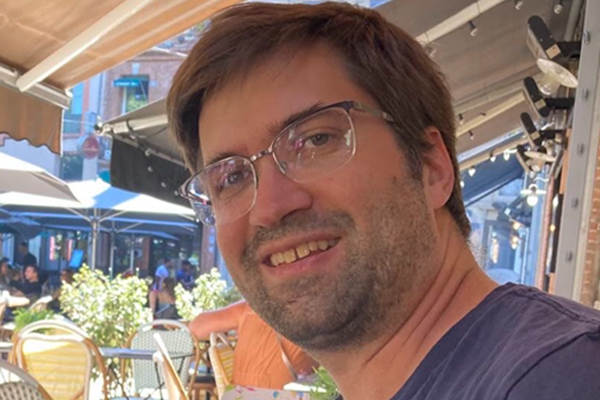Alumnus: Tim Daoust

Current Position / Employer: Lead Animation Programmer at Epic Games
Degree with Department Affiliation and Graduation Date: MSc Computer Science 2004
Thesis Title: A System for Performance and Keyframe Animation Using Virtual Reality and Motion Capture
1. Tell us what you are doing professionally at the current time (please include specific projects you have worked on):
I’m currently the lead programmer for the Unreal Engine animation runtime and synthesis teams at Epic Games. In this role, I build and maintain tools that empower animators to bring their characters to life in both video games and films. The most well known area of my responsibilities include the animation blueprints system in Unreal, which combines animation clips into a cohesive performance. I also lead the development of physically based animation and machine learning deformation systems, pushing the boundaries of what’s possible in digital animation.
My journey with Unreal Engine follows two decades of experience in the animation industry. Previously, I was a principal programmer for the Euphoria and Morpheme animation systems, which are the backbone of the dynamic ragdoll physics in iconic games such as "Grand Theft Auto IV," "GTA V," and "Red Dead Redemption." These systems allowed characters to interact with their environments in lifelike ways, contributing to the immersive experience of the games. A few years before joining Epic, I co-founded WeightShift, a company that specialized in creating physically based animation tools for Maya. These tools are used in the VFX industry and have been featured in numerous films and TV shows, showcasing the blend of artistry and technical capabilities.
2. What inspires your creativity today?
It’s incredible to see what game development teams can achieve with limited CPU and memory resources, bringing hundreds of characters to life on screen with impressive quality. I love talking to teams at GDC or on the Unreal Engine forums to discover their innovative approaches to technology and techniques. Current research presented at Siggraph is particularly inspiring, and we constantly strive to integrate the latest ideas into shipped games.
Artistically, I’m inspired by animators and motion editors. Working directly with large VFX studios, I witnessed the development of different shots daily. Seeing animators use my tools to bring characters to life always motivates me to find better and faster solutions to help them achieve their vision.
3. Tell us one “Aha” moment from your experience of studying, researching, or working at ACCAD.
One significant “Aha” moment was learning the Maya API and MEL scripting during my first animation course at ACCAD. The simplicity and elegance of the directed acyclic graph and directed graph architecture in Maya compared to the less flexible approach in 3ds Max taught me the importance of a unified software architecture. Maya’s embedded scripting language, which allowed users to adapt the technology to their needs and served as the foundation for the interface, highlighted the importance of adaptability. These principles have kept Maya dominant for 20 years, and I aim to incorporate them into my own software development.
4. What would you say to your “Undergraduate” or “Graduate” self about studying at Ohio State now that you have graduated? Or what advice would you give to current students taking classes at ACCAD?
Participating in the study abroad program at Ohio State was life-changing. I recommend every undergraduate visit the Office of International Affairs to explore available programs. I’ve never met anyone who regretted studying abroad, and many consider it the highlight of their undergraduate career.
Additionally, I strongly suggest seeking a position as an undergraduate or graduate researcher. While finding a supportive professor might be challenging, it’s a much easier path to gaining meaningful experience than waiting until after graduation. Future employers will prioritize your achievements and capabilities over your GPA.
5. How could Ohio State better prepare people for a career that combines art, design, computer science, digital media and new technologies?
In my experience in the VFX and games industry in England, NCCA at Bournemouth University consistently places graduates in top London studios (MPC, Framestore, DoubleNegative, etc.). I recommend watching the NCCA Undergraduate showreel to compare your preparation with that of other undergraduates competing for similar positions.
6. What most helps you to balance life and career expectations? How do you relax or de-stress?
Drawing and painting help balance the technical aspects of my life, along with as much travel as possible.
7. Tell us a fun thing (or something) most people don’t know about you?
Since leaving Ohio State, I’ve trained as a classical artist using the atelier (workshop) method. This tradition, dating back to the 18th and 19th centuries, involves accomplished artists working alongside students in an artistic community to practice core skills and pass on knowledge. Now, I split my time between programming and painting portraits and landscapes in oil.
8. What would an alternate career choice be, if you could go back and choose a different path?
I think I would have enjoyed being a concept artist or film animator. Spending time embedded with animators at Framestore and Weta while developing software was also incredibly fulfilling, so I could see myself working in a rigging or CFX department at a major studio, creating custom solutions for specific shots.
